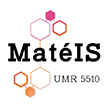Microstructural characterisation
Aims
The main objective here is the development of innovative techniques for characterising ceramic materials by adapting to the special features of the different types of material studied by the team. The main features of these materials are the insulating characteristics, the possibility of having organic phases in composites and the porosity of certain samples.
Activities
The MATEIS laboratory has a scanning electron microscope that works at low voltage and in VP mode (the nitrogen is pressure-controlled in the chamber to the order of 20 Pa), equipped with an EDS detector (dispersive energy analysis) and EBSD camera (electron backscatter diffraction), a transmission electron microscope and an X-ray diffractometer with two furnaces (-70-450°C and 30-1200°C). MATEIS belongs to CLYM (Centre Lyonnais de Microscopie) which enables access to innovative microscopes:
- an environmental scanning electron microscope equipped with an EDS detector
- a dual tube Focused Ion Beam (FIB) microscope equipped with an EDS detector and EBSD camera (electron backscatter diffraction)
- a high resolution transmission electron microscope with EDS detector, electron energy loss spectroscopy (EELS) and an HAADF (incoherently scattered electrons at high angles) detector
- an environmental tomographic transmission electron microscope (ETTEM)
Different techniques are often coupled to achieve the most complete characterisation of materials possible (as, for example, with organic-mineral composites for the building industry). In situ techniques enabling us to follow the evolution of materials subject to mechanical stress in real time or at temperature are included in our current developments.
- DRX: high temperature furnaces, microdiffraction
- MEB SUPRA 55 VP: imaging, EBSD
Low-voltage imaging / VP (P N2<1 torr): no plating, EBSD in VP mode
- ESEM: Partial gas pressure (H2O, N2, air) <10 torrs; 1000°C-1500°C furnaces:
Cement hydration, in-situ sintering monitoring, behaviour of ceramic materials at temperature, elevated temperature tensile testing/hot pressing
- 2010F: EDS, EELS, PO nanoindentation
Characterisation of Al2O3-SiC grain joints, monitoring the transformation phase of zirconia / the behaviour of aluminium oxide grains under tensile stress
- LEO 912: Energy filter in the tube, possibility of working from 80 to 120kV
Characterisation of nanoparticles in cancerous cells to follow their internalisation
- FIB:
Sample preparation: thin strips, 3D reconstruction of dental implants (tomography)

